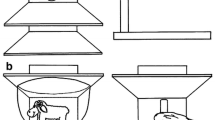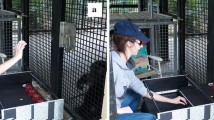Abstract.
The ability to seriate nesting cups as a sensorimotor task has posed interesting questions for cognitive scientists. Greenfield et al. [(1972) Cognit Psychol 3:291–310] found parallels between children’s combinatorial activity with nesting cups and patterns of phonological and grammatical constructions. The parallels suggested the possibility of a neurally based developmental homology between language and instrumental action [Greenfield (1991) Behav Brain Sci 14:531–595]. Children who predominantly used subassembly, a hierarchical method of combining cups, succeeded at seriating nesting cups more often than those who did not. Greenfield and others [e.g., Piaget and Inhelder (1969) The psychology of the child. Basic Books, New York; DeLoache et al. (1985) Child Dev 56:928–939] argued that success in seriation reflects the child’s growing recognition of a reversible relationship: a particular element in a series is conceived of as being smaller than the previous element and larger than the subsequent element. But is a concept of reversibility or a hierarchical form of object manipulation necessary to seriate cups? In this article, we review studies with very young children and nonhuman primates to determine how individuals that do not evidence conceptual reversibility manage the seriation task. We argue that the development of skill in seriation is experientially, rather than conceptually, driven and that it may be unnecessary to link seriation with cognitive conceptions of reversibility or linguistic capacities. Rather, in ordering a set of objects by size, perceptual-motor learning may enable contemplative refinement.
Similar content being viewed by others
Author information
Authors and Affiliations
Additional information
Accepted after revision: 10 September 2001
Electronic Publication
Rights and permissions
About this article
Cite this article
Johnson-Pynn, J., Fragaszy, D.M. Do apes and monkeys rely upon conceptual reversibility?. Anim.Cogn. 4, 315–324 (2001). https://doi.org/10.1007/s10071-001-0117-4
Received:
Published:
Issue Date:
DOI: https://doi.org/10.1007/s10071-001-0117-4




